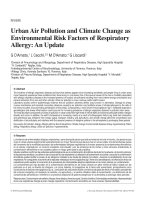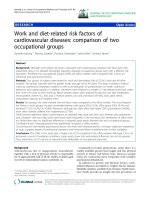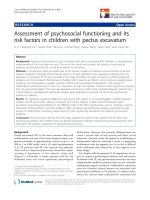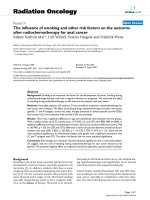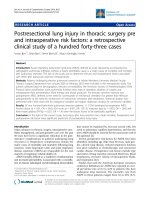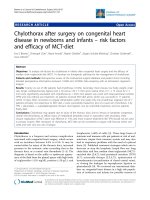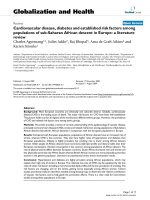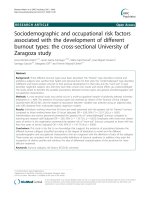Socio-demographic, environmental and behavioural risk factors of diarrhoea among under-five children in rural Ethiopia: Further analysis of the 2016 Ethiopian demographic and health survey
Bạn đang xem bản rút gọn của tài liệu. Xem và tải ngay bản đầy đủ của tài liệu tại đây (695.13 KB, 9 trang )
Ferede BMC Pediatrics
(2020) 20:239
/>
RESEARCH ARTICLE
Open Access
Socio-demographic, environmental and
behavioural risk factors of diarrhoea among
under-five children in rural Ethiopia: further
analysis of the 2016 Ethiopian
demographic and health survey
Melkamu Molla Ferede
Abstract
Background: Diarrhoea is one of the major contributors to death among under-five children in Ethiopia. Studies
conducted in different countries showed that rural children are more severely affected by diarrhoea than urban
children. Thus, this study was aimed to identify the socio-demographic, environmental and behavioural associated
risk factors of the occurrence of diarrhoea among under-five children in rural Ethiopia.
Methods: Data for the study was drawn from the 2016 Ethiopian Demographic and Health Survey. A total of 8041
under-five children were included in the study. Binary logistic regression was used to assess the association of
occurrence of diarrhoea with socio-demographic, environmental and behavioural factors among under-five children.
Results: Children aged 6–11 months (AOR:3.5; 95% CI: 2.58–4.87), 12–23 months (AOR: 3.1; 95% CI: 2.33–4.04) and 24–
35 months (AOR: 1.7; 95% CI: 1.26–2.34) as compared to > 35 months were significantly associated with an increasing
prevalence of diarrhoea. Children in Afar region (AOR: 1.92; 95% CI: 1.01–3.64) and Gambela region (AOR: 2.12; 95% CI:
1.18, 3.81) were significantly associated with an increasing prevalence of diarrhoea, but a decreasing prevalence in
Somali region (AOR: .42; 95% CI: (.217–.80) as compared to Tigray region. Increasing prevalence of diarrhoea was also
significantly associated with male children (AOR: 1.3; 95% CI: 1.05–1.58); households who shared toilet facilities with
other households (AOR: 1.4; 95% CI: 1.09–1.77); fourth birth order (AOR: 1.81; 95% CI: 1.17–2.79), and fifth and above
birth order (AOR: 1.85; 95% CI: 1.22, 2.81) as compared to first order; and mother’s current age 35–49 years in a
household with ≥3 under-five children (AOR: 4.7; 95% CI: 1.64–13.45) as compared to those maternal ages of 15–24
years in a household with ≤2 under-five children.
Conclusion: The age of a child, sex of a child, region, birth order, toilet facilities shared with other households and the
interaction effect of the number of under-five children with mother’s current age are identified as associated risk
factors for diarrhoea occurrence among under-five children in rural Ethiopia. The findings show the need for planning
and implementing appropriate prevention strategies considering these risk factors for rural under-five children.
Keywords: Diarrhoea, Risk factors, Under-five children, Rural Ethiopia
Correspondence:
Department of Statistics, College of Natural and Computational Science,
University of Gondar, Gondar, Ethiopia
© The Author(s). 2020 Open Access This article is licensed under a Creative Commons Attribution 4.0 International License,
which permits use, sharing, adaptation, distribution and reproduction in any medium or format, as long as you give
appropriate credit to the original author(s) and the source, provide a link to the Creative Commons licence, and indicate if
changes were made. The images or other third party material in this article are included in the article's Creative Commons
licence, unless indicated otherwise in a credit line to the material. If material is not included in the article's Creative Commons
licence and your intended use is not permitted by statutory regulation or exceeds the permitted use, you will need to obtain
permission directly from the copyright holder. To view a copy of this licence, visit />The Creative Commons Public Domain Dedication waiver ( applies to the
data made available in this article, unless otherwise stated in a credit line to the data.
Ferede BMC Pediatrics
(2020) 20:239
Background
According to World Health Organisation (WHO), diarrhoea is defined as the passage of three or more loose or
liquid stools per day (or more frequent passage than is
normal for the individual) [1]. Diarrhoea is usually a
symptom of an infection in the intestinal tract, which
can be caused by a variety of bacterial, viral and parasitic
organisms. It can last several days and can leave the
body without the water and salts that are necessary for
survival. It depletes the body fluids and can cause severe
dehydration, which can lead to death if not treated properly. Furthermore, severe dehydration and fluid loss are
the direct causes of diarrhoeal death for most people [1].
Diarrhoea is a leading cause of malnutrition [2] and
the second leading cause of death in children under 5
years old being responsible for killing around 525,000
children every year. Globally, there are nearly 1.7 billion
cases of childhood diarrhoeal disease every year [1].
According to United Nations International Children’s
Emergency Fund (UNICEF), 88% of all diarrhoeal deaths
in 2015 were concentrated in South Asia and sub-Saharan
Africa [2]. Low and lower-middle-income countries are
home to 62% of the world’s under-five population but account for more than 90% of global pneumonia and diarrhoeal death [2]. In low-income countries, children under
3 years old experience on average three episodes of diarrhoea every year [1].
Ethiopia is one of the top 10 countries with the highest
number of diarrhoeal deaths. Based on UNICEF report,
15,500 diarrhoeal deaths occurred among under-five
children in Ethiopia in 2015 [2]. The 2005, 2011 and
2016 Ethiopian Demographic and Health Survey (EDHS)
reports showed that the percentage of under-five children
who had diarrhoea in the 2 weeks before the survey period
were 18, 13 and 12%, respectively [3]. Even though the
magnitude of diarrhoea have reduced over the past periods, diarrhoeal disease is still the major cause of morbidity and mortality among children in Ethiopia.
Studies conducted in different countries showed that
rural children are more severely affected by diarrhoea
than urban children [4–6]. The 2016 EDHS report
showed that under-five children in rural Ethiopia had,
relatively, more diarrhoea occurrence than urban ones
[3]. Even though magnitude of diarrhoea disease in rural
Ethiopia is high, there are limited pocket studies conducted at District/Zone/Town level to assess diarrhoeal
disease and associated risk factors. Moreover, there is no
study at the country/national level, which focused specifically on the rural part of the country, to show associated
risk factors of diarrhoea occurrence among under-five
children. So, evidence based information is needed for a
child’s health improvement strategy by preventing and reducing the severity of diarrhoeal in under-five children in
rural Ethiopia. Thus, this study was conducted to fill this
Page 2 of 9
gap by identifying the socio-demographic, environmental
and behavioural associated risk factors of the occurrence
of diarrhoea among children aged under 5 years in rural
Ethiopia.
Methods
Study design and setting
This study was based on a national community-based
cross-sectional study, EDHS 2016, in Ethiopia. The
EDHS 2016 was conducted from January 18, 2016, to
June 27, 2016. The survey was the fourth survey in the
country. More details can be accessed from the EDHS
2016 report [3].
Sampling design and data
The sampling frame used for the 2016 EDHS was the
2007 Ethiopian Population and Housing Census frame,
which was provided by the Central Statistical Agency
(CSA). The 2016 EDHS samples were selected using two
stages stratified sampling procedure. Each region was
stratified into urban and rural areas, which yielded 21
(11 urban and 10 rural) sampling strata. Samples of enumeration areas (EAs) were selected independently in
each stratum in two stages. In 2016 EDHS, a sample of
10,641 under-five children represented by interviewed
mothers were included. Out of these children, a complete
response about the two-week occurrence of diarrhoea was
obtained for 9916. Among them, 1875 children were from
urban residences. Hence, after children with no response
about the diarrhoea case and those from urban parts of
Ethiopia being excluded, 8041 under-five children with
complete information were used as the data for this study.
Thus, for this study, all under-five children in rural
parts of Ethiopia were extracted from the EDHS 2016
data. EDHS 2016 was retrieved from major DHS after
describing the objective of the study.
Study variables
The response variable was the reported occurrence of
diarrhoea. The mother was asked if the child had diarrhoea in the last 2 weeks.
The independent variables included in the study were
identified from literature conducted earlier and associated with the occurrence of diarrhoea among under-five
children [4, 7–13]. These are the socio-demographic variables (current age of mother, sex of child, current age of
child, child lives with whom, region, mother educational
level, religion, birth order, work status of the mother,
household wealth index, number of under-five children
in the household, current marital status of the mother,
current breastfeeding status and number of household
members); environmental and behavioural variables
(source of drinking water, type of toilet facility, if toilet
facility is shared with other households, disposal of
Ferede BMC Pediatrics
(2020) 20:239
youngest child’s stools when not using toilet and main
floor material).
Data analysis methods
After the extracted data were checked for completeness
and coded, the analyses were done using SPSS Version
23. Data were described and summarized through frequencies and percentages. To study the effect of the different independent variables on the response variable,
bivariate and multivariable analysis were used. In bivariate analysis, chi-square test of association and crude
odds ratio were estimated to assess the association between each of the independent variables and the response variable. The backward stepwise method was
used to select variables for the best-reduced model and
Wald-test was used to test individual significance of the
coefficients of the model.
A multivariable binary logistic regression model was
used to identify associated risk factors of diarrhoea occurrence among under-five children. The overall goodness of
the final model was checked using the Hosmer-Lemeshow
goodness-of-fit test. Interpretations of the strength of the
associations between associated risk factors and the response variable were based on significant adjusted odds
ratios (AOR) with their respective 95% confidence intervals at 5% level of significance (p-value < 0.05).
Results
Socio-demographic, environmental and behavioural
characteristics of the study participants
The study included 8041 under-five children. Out of
these 3938 (49.0%) were females, 891 (11.1%) were less
than 6 months and 3265 (40.6%) were age greater than
35 months (Table 1). The majority of the children 5459
(67.9%) were currently breastfeeding at the time of the
survey. Around 4774 (59.4%) of the children were from
households with six or more family members. Regarding
mothers, 5801 (72.1%) had no formal education and
7659 (95.2%) were married.
Concerning the environmental and behavioural characteristics of the households, 3713 (46.7%) of mothers/
caregivers have used unimproved source of drinking
water (Table 2). There were 3262 (41.0%) unimproved
toilet facility and 4103 (51.6%) no toilet facility in the
household. Furthermore, around 3171 (61.0%) of the
mothers/caregivers were not properly discarding the
youngest child’s stools.
Prevalence of Diarrhoea
The two-week prevalence of diarrhoea among under-five
children was 11.2% (95% CI: 10.5–11.9%) in rural
Ethiopia. The result displayed in Tables 1 and 2 showed
that the occurrence of diarrhoea was highest among
children age 6–11 months (18.9%) and 12–23 months
Page 3 of 9
(18.1%). For ease of comparison, visual display for the
prevalence of diarrhoea by age among children is also
given (Fig. 1]. The highest prevalence of diarrhoea was
also observed in children living in southern Nations
Nationalities and People’s region (SNNPR) (14.3%),
whose household shared toilet facility with other households (13.9%), protestant followers’ children (13.5%) and
widowed/separated mothers’ children (13.1%). Tables 1
and 2 also show that there are other socio-demographic,
environmental and behavioural characteristics of the
children that the occurrence of diarrhoea was above the
overall average (11.2%).
Associated risk factors of Diarrhoea
In bivariate analysis, the chi-square test results (Tables 1
and 2) and the estimated crude odds ratios (Table 3)
showed that there were a significant association between
occurrence of diarrhoea and mother’s current age, sex of
a child, current age of a child, region, number of underfive children, wealth index of the household, religion,
number of household members, current breastfeeding
status, type of toilet facility and toilet facilities shared
with other households at 5% level of significance.
In multivariable analysis, the Hosmer-Lemeshow
goodness-of-fit test result (P-value = 0.763) showed
that the final multivariable binary logistic regression
model was a good fit to the data.
The result showed that current age of child [6–11
months (AOR: 3.5; 95% CI: 2.58–4.87), 12–23 months
(AOR: 3.1; 95% CI: 2.33–4.04) and 24–35 months (AOR:
1.7; 95% CI: 1.26–2.34) as compared to > 35 months],
sex of child [male (AOR: 1.3; 95% CI: 1.05–1.58)], region
[Afar (AOR: 1.92; 95% CI: 1.01–3.64), Somali (AOR:
0.42; 95% CI: (0.217–0.80) and Gambela (AOR: 2.12;
95% CI: 1.18–3.81) as compared to Tigray region], birth
order [4th (AOR: 1.81; 95% CI: 1.17–2.79), 5th and
above (AOR: 1.85; 95% CI: 1.22–2.81) as compared to
1st order], toilet facilities shared with other households
(AOR: 1.4; 95% CI: 1.09–1.77) and mother’s current age
35–49 years in a household with three or more underfive children (AOR: 4.7; 95% CI: 1.64–13.45) as compared to those maternal age of 15–24 years in a household with less than or equal to two under-five children
were statistically significant associated risk factors of
diarrhoeal occurrence among under five children at 5%
level of significance (Table 3).
Discussion
This study was intended to identify demographic, environmental and behavioural associated risk factors of the
occurrence of diarrhoea among under-five children in
rural Ethiopia based on 2016 EDHS data.
In this study, the variables current age of a child, sex
of a child, region, birth order, toilet facilities shared with
Ferede BMC Pediatrics
(2020) 20:239
Page 4 of 9
Table 1 Socio-demographic characteristics related to under-five children and their bivariate analysis with the occurrence of
diarrhoea in rural Ethiopia
Variables
χ2-test
Had diarrhoea recently
Counts (%)
No (%)
Yes (%)
15–24
1972(24.5)
1724 (87.4)
248 (12.6)
25–34
4080 (50.7)
3610 (88.5)
470(11.5)
35–49
1989(24.7)
1803(90.6)
186(9.4)
Male
4103(51.0)
3613(88.1)
490(11.9)
Female
3938(49.0)
3524(89.5)
414(10.5)
Current age of mother (year)
P-value
0.004
Sex of child
0.042
Current age of child
0.000
< 6 month
891(11.1)
816(91.6)
75(8.4)
6–11
801(10.0)
650(81.1)
151(18.9)
12–23
1517(18.9)
1243(81.9)
274(18.1)
24–35
1567(19.5)
1378(87.9)
189(12.1)
> 35 month
3265(40.6)
3050(93.4)
215(6.6)
Education of mother
0.050
No formal education
5801(72.1)
5182(89.3)
619(10.7)
Primary
1912(23.8)
1667(87.2)
245(12.8)
Secondary
270(3.4)
235(87.0)
35(13.0)
Higher
58(0.7)
53(91.4)
5(8.6)
Tigray
820(10.2)
726(88.5)
94(11.5)
Afar
879(10.9)
787(89.5)
92(10.5)
Amhara
838(10.4)
725(86.5)
113(13.5)
Oromia
1414(17.6)
1250(88.4)
164(11.6)
Somali
1106(13.8)
1032(93.3)
74(6.7)
Benishangul
765(9.5)
692(90.5)
73(9.5)
SNNP
1104(13.7)
946(85.7)
158(14.3)
Gambela
491(6.1)
431(87.8)
60(12.2)
Harari
364(4.5)
320(87.9))
44(12.1)
Dire Dawa
260(3.2)
228(87.7)
32(12.3)
Region
0.000
Number of under 5 children in a household
0.001
2 or less
6342(78.9)
5589(88.1)
753(11.9)
3 and above
1699(21.1)
1548(91.1)
151(8.9)
Poor
5194(64.6)
4649(89.5)
545(10.5)
Middle
1332(16.6)
1167(87.6)
165(12.4)
Rich
1515(18.8)
1321(87.2)
194(12.8)
1st order
1362(16.9)
1195(87.7)
167(12.3)
2nd
1224(15.2)
1103(90.1)
121(9.9)
3rd
1152(14.3)
1011(87.8)
141(12.2)
Wealth index of the household
0.015
Birth order number
0.185
4th
1062(13.2)
935(88.0)
127(12.0)
5th and above
3241(40.3)
2893(89.3)
348(10.7)
Ferede BMC Pediatrics
(2020) 20:239
Page 5 of 9
Table 1 Socio-demographic characteristics related to under-five children and their bivariate analysis with the occurrence of
diarrhoea in rural Ethiopia (Continued)
Variables
χ2-test
Had diarrhoea recently
Counts (%)
No (%)
Yes (%)
2108(26.20)
1859(88.2)
249(11.8)
Religion
Orthodox
P-value
0.011
Catholic
46(0.6)
40(87.0)
6(13.0)
Protestant
1492(18.6)
1291(86.5)
201(13.5)
Muslin
4232(52.6)
3801(89.8)
431(10.2)
Traditional/other
163(2.0)
146(89.6)
17(10.4)
Not working
6046(75.2)
5390(89.1)
656(10.9)
Working
1995(24.8)
1747(87.6)
248(12.4)
Mother’s current work status
0.053
Mother’s marital status
0.242
Married/Living with partner
7659(95.2)
6805(88.8)
854(11.2)
Widowed/separated/never in union
382(4.8)
332(86.9)
50(13.1)
5 and fewer
3267(40.6)
2872(87.9)
395(12.1)
6 and above
4774(59.4)
4265(89.3)
509(10.7)
Number of household members
0.046
Child lives with whom
0.141
Mother
7904(98.30)
7010(88.7)
894(11.3)
Other caregiver
137(1.70)
127(92.7)
10(7.3)
No
2582(32.1)
2333(90.4)
249(9.6)
Yes
5459(67.9)
4804(88.0)
655(12.0)
Currently breastfeeding
0.002
χ2 Chi-square
other households and the interaction effect of number of
under-five children with age of mother were identified
as associated risk factors for under-five diarrhoeal disease occurrence.
The result indicated that child’s age group 6–11, 12–
23 and 24–35 months were 3.5, 3.1 and 1.7 times more
affected by diarrhoea than child’s age greater than 35
months respectively after adjusting for the effect of other
variables. In general, children age greater than 35
months had a lower risk of having diarrhoea than children whose age between 6 and 35 months. This may be
due to the fact that children whose age between 6 and
23 months begin supplementary foods and also they start
crawling and can touch contaminated materials in unclean environment and immediately return their hand to
mouth, so this may cause them to be easily exposed to
diarrhoeal disease. The 2016 EDHS also reported that
diarrhoea prevalence remains high (18%) at age of 12–
23 months, which is the time when children begin walking and are at increased risk of contamination from the
environment [3]. Recent studies and scientific knowledge
also show that a lot of diarrhoea in this age is due to
rotavirus. For instance, a study conducted in Farta
Woreda, North West Ethiopia showed that children
age 6–11 months and not vaccinated for rotavirus are
highly affected by diarrhoea [14, 15]. A study in
Burkina Faso also showed that rotavirus is more
prevalent in young children (< 12 months) and children less than 12 months of age were susceptible to
diarrhoea [16]. Therefore, the role of rotavirus vaccines is also important. Moreover, increased risk of
disease in younger children might be due to naive immune system in children of younger ages and waning
of maternal antibodies [16–21]. The finding of this
study is also in line with studies done in Benishangul
region, Eastern Ethiopia, Enderta Woreda, Wolitta
Soddo and southern Ethiopia [4, 7, 22–25].
Sex of a child had a significant association with diarrhoea occurrence. Male children were 1.3 times more affected by diarrhoea than female children after adjusting
for the effect of other variables. A study conducted in
Dhaka, Bangladesh in 2018 similarly concluded that
more boys presented with acute diarrhoeal illness than
girls [26]. This might be because of possibility of a sex-
Ferede BMC Pediatrics
(2020) 20:239
Page 6 of 9
Table 2 Environmental and behavioural characteristics related to under-five children and their bivariate analysis with the occurrence
of diarrhoea in rural Ethiopia
Variables
χ2-test
Had Diarrhoea recently
Counts (%)
No (%)
Yes (%)
Improved water
4241(53.3)
3763(88.7)
478(11.3)
Unimproved
3713(46.7)
3305(89.0)
408(11.0)
Source of drinking water
P-value
0.689
Type of toilet facility
0.034
Improved toilet facility
589(7.4)
530(90.0)
59(10.0)
Unimproved toilet facility
3262(41.0)
2863(87.8)
399(12.2)
No Facility/bush/field
4103(51.6)
3675(89.6)
428(10.4)
Toilet facilities shared with other household
0.041
No
2986(77.5)
2648(88.7)
338(11.3)
Yes
865(22.5)
745(86.1)
120(13.9)
Proper disposal
2013(38.8)
1754(87.1)
259(12.9)
Improper disposal
3171(61.2)
2816(88.8)
355(11.2)
Natural floor
7413(93.2)
6594(89.0)
819(11.0)
Rudimentary floor
72(0.9)
63(87.5)
9(12.5)
Finished floor
469(5.9)
411(87.6)
58(12.4)
Disposal of youngest child’s stools
0.070
Main floor material
0.634
χ2 Chi-square
Fig. 1 Age-specific prevalence of diarrhoea among under-five children. The heights of the bars show the prevalence of diarrhoea highly increases
among children age from 6 months to 11 months, and then gradually decreases to age above 35 months
Ferede BMC Pediatrics
(2020) 20:239
Page 7 of 9
Table 3 Multivariable binary logistic regression analysis of the effects of socio-demographic and environmental associated risk
factors of occurrence of diarrhoea among under-five children in rural Ethiopia
Variables
COR(95% CI)
AOR(95% CI)
P-value for AOR
[15–24]
–
–
–
25–34
0.90(0.77, 1.07)
0.66(0.47, 0.93
0.016
35–49
0.72(0.59, 0.88)**
0.36(0.23, 0.58)
0.000
(Female)
–
–
–
Male
1.15(1.00, 1.33)*
1.29(1.05, 1.58)
0.013
[> 35 month]
–
–
–
< 6 month
1.30(0.99, 1.71)
1.34(0.91, 1.99)
0.140
6–11
3.30(2.63, 4.13)**
3.54(2.58, 4.87)
0.000
12–23
3.13(2.59, 3.78)**
3.07(2.33, 4.04)
0.000
24–35
1.95(1.58, 2.39)**
1.72(1.26, 2.34)
0.001
[Tigray]
–
–
–
Afar
0.90(0.67, 1.22)
1.91(1.01, 3.64)
0.047
Amhara
1.20(0.90, 1.61)
1.51(0.93, 2.46)
0.095
Oromia
1.01(0.77, 1.33)
1.24(0.80, 1.91)
0.338
Somali
0.55(0.40, 0.76)**
0.42(0.22, 0.80)
0.009
Benishangul
0.81(0.59, 1.12)
0.95(0.60, 1.52)
0.844
SNNP
1.290(.98, 1.69)
1.39(.90, 2.15)
0.134
Gambela
1.07(.76, 1.52)
2.12(1.18, 3.81)
0.012
Harari
1.06(.72, 1.55)
0.89(0.49, 1.62)
0.698
Dire Dawa
1.08(.71, 1.66)
0.72(0.31, 1.65)
0.440
–
–
–
2nd
0.78(0.61, 1.01)
0.91(0.62, 1.34)
0.647
3rd
0.99(0.79, 1.27)
1.48(0.98, 2.22)
0.059
4th
0.97(0.76, 1.24)
1.81(1.17, 2.79)
0.007
5th and above
0.86(0.71, 1.05)
1.85(1.22, 2.81)
0.004
[No]
–
–
–
Yes
1.26(1.01, 1.58)*
1.39(1.09, 1.77)
0.008
Current age of mother
Sex of child
Current age of child
Region
Birth order number
[1st order]
Toilet facilities shared with other households
No. of under 5 children*Age of mother
[(2 or less)*(15–24)]
–
–
NoChildU5(≥3) by ageM(25–34)
2.46(0.96, 6.30)
0.060
NoChildU5(≥3) by ageM(35–49)
4.70(1.64, 13.45)
0.004
The reference categories are those indicated in square brackets
*Statistically significant variables at p < 0.05; **statistically significant variables at p < 0.01
based difference in the pathophysiology of acute pediatric
diarrhoea that we do not yet understand [26].
The study also revealed that the occurrence of diarrhoea was significantly associated with region of the
mother. Children in rural Afar and rural Gambela
regions were twice as likely to be affected by diarrhoea
as compared to children in rural Tigray region. However, under-five children from the rural Somali region
were 0.45 times less likely to be affected by diarrhoea
than those from rural Tigray region.
Ferede BMC Pediatrics
(2020) 20:239
Households those shared toilet facility with other
households had a significant association with diarrhoeal
disease. Children from households with shared toilet facility had around 39% more risk for having diarrhoea
than those from households who did not share toilet facilities. Thus, children under the age of five face an increased risk of contracting diarrhoea when they share a
toilet with just one or two other households. Epidemiological studies have identified an increased risk of diarrhoeal diseases associated with using shared sanitation
facilities. A similar study conducted using data from 51
countries’ demographic and health surveys found that
shared sanitation appears to be a risk factor for diarrhoea
although differences in socioeconomic status are important [27]. An analytical review study conducted by Ramlal
et al. in 2019 also found that the use of shared sanitation
showed a significant increase in diarrhoeal disease, with
an overall OR of 2.39 (85% CI 1.15–8.31) [28].
Children whose birth order 4th and 5th and above
were around 1.8 times more likely to be affected by diarrhoea than 1st order children. This result was in line
with the findings in the Benishangul Gumuz region [7]
and in Jigjiga district, Somali region [29].
The effect of number of under-five children in the
household on childhood diarrhoea varies by current age
of mothers. Number of under-five children affects the
occurrence of diarrhoea differently in older age mothers
(35–49) versus younger age mothers (15–24). The odds
of the occurrence of diarrhoea for three or more number
of under-five children (relative to two or less number of
under-five children) in older age mothers was 4.7 times
as high as in younger age mothers. In other words,
mother’s current age 35–49 years in a household with
three or more under-five children had significantly
greater prevalence of diarrhoea as compared to those
maternal age of 15–24 years in a household less than or
equal to 2 under-five children. Older mothers, on average, can have a higher number of children as compared
to younger ones. As a result, it may be difficult to give
care effectively when the number of under-five children
becomes large in a household and then it may be a cause
for the occurrence of diarrhoea. Therefore, to control
the number of under-five children the role of family
planning is important. Effective family planning can also
reduce the number of high birth ordered children in the
household. This finding is consistent with a study done in
eastern Ethiopia [4], the Benishangul Gumuz region [7],
northeast Ethiopia [30] and in northwest Tigray [31].
Limitations
In this study, possible modifiable risk factors like rotavirus
vaccine, hand washing, malnutrition status, and others
were not included as they were captured with high
Page 8 of 9
missing values in the secondary data used for this study.
The readers are requested to take this into account.
Conclusion
The age of a child, sex of a child, region, birth order, toilet
facilities shared with other households and the interaction
effect of number of under-five children with current age
of mothers are identified as associated risk factors for diarrhoea occurrence among under-five children in rural
Ethiopia. The findings show the need for planning and
implementing appropriate prevention strategies considering the identified risk factors that target rural under-five
children. For instance, strategies for reducing the number
of under-five children and birth order in the household as
well as supportive strategies about household sanitation
facilities (toilet facility and its usage), and women education on appropriate child care practices tailored by their
age might reduce prevalence of diarrhoea. Further research is recommended to investigate the determinants of
diarrhoea using primary data including all modifiable associated risk factors like rotavirus vaccine, hand washing,
malnutrition status, and others in rural Ethiopia.
Abbreviations
AOR: Adjusted Odds Ratio; CI: Confidence interval; COR: Crude odds Ratio;
CSA: Central Statistical Agency; DHS: Demographic and Health Survey;
EAs: Enumeration Areas; EDHS: Ethiopia Demographic and Health Survey;
SNNPR: Southern Nations, Nationalities, and People’s Region; UNICEF: United
Nations International Children’s Emergency Fund
Acknowledgements
I would like to thank Central Statistical Agency and USAID’s DHS program for
providing me the data used in this study for free. I would like to express my
deepest gratitude to Kindie Fentahun Muchie (Assistant Prof.) for his
unreserved support.
Author’s contributions
The author, MMF, designed the study, done data acquisition, performed the
statistical data analysis, interpreted the results and prepared the manuscript.
The author also read and approved the final manuscript.
Author’s information
The author currently works at the University of Gondar, Gondar, Ethiopia. He
serves as a Lecturer and Researcher in Statistics Department, College of Natural
and Computational Science. He obtained both Master of Science in Biostatistics
and Bachelor of Science in Statistics from University of Gondar, Ethiopia.
Funding
No external funds received for this study.
Availability of data and materials
The general datasets are available from the Central Statistical Agency and the
DHS Program data home, USAID. Specifically, the minimal data used for this
study are available from the corresponding author on reasonable request.
Ethics approval and consent to participate
Ethical clearance for the 2016 EDHS was provided by the Ministry of Health
ethics committee, the National Research Ethics Review Committee (NRERC), the
Institutional Review Board of Inner City Fund (ICF) at DHS program
internationally, and the Government of Ethiopia. All respondents to the survey
provided verbal informed consent. The Author obtained the 2016 EDHS data
by written request from the Central Statistical Agency in Ethiopia. Furthermore,
the author also obtained the 2016 EDHS data in different reading formats by
online request at the DHS program, USAID (www.DHSprogram.com).
Ferede BMC Pediatrics
(2020) 20:239
Consent for publication
Not applicable.
Competing interests
The author declares that he has no competing interests.
Received: 17 September 2019 Accepted: 12 May 2020
References
1. World Health Organization. Diarrhoeal disease: a report on May 02, 2017.
/>Accessed 15 Aug 2019.
2. UNICEF. One is too many: ending child deaths from pneumonia and
diarrhoea. In: Every breath count; 2016.
3. Central Statistical Agency [Ethiopia] and ICF. Ethiopia demographic and
health survey 2016. Addis Ababa: CSA and ICF; 2016.
4. Mengistie B, Berhane Y, Worku A. Prevalence of diarrhoea and associated
risk factors among children under-five years of age in Eastern Ethiopia: a
cross-sectional study. Open J Prev Med. 2013;3(7):446–53.
5. Bbaale E. Determinants of diarrhoea and acute respiratory infection among
under-fives in Uganda. Aust Med J. 2011;4:400–9.
6. El Gilany AH, Hammad S. Epidemiology of diarrhoeal diseases among
children under age 5 years in Dakahlia, Egypt. East Mediterr Health J. 2005;
11(4):762–75.
7. Mihrete TS, Alemie GA, Teferra AS. Determinants of childhood diarrhoea
among under-five children in Benishangul Gumuz regional state, North
West Ethiopia. BMC Pediatr. 2014;14(1):102.
8. Getachew A, Guadu T, Tadie A, Gizaw Z, Gebrehiwot M, Cherkos DH, et al.
Diarrhoea prevalence and sociodemographic factors among under-five
children in rural areas of North Gondar Zone, Northwest Ethiopia. Hindawi
Int J Pediatr. 2018;2018:6031594.
9. Hussein H. Prevalence of diarrhoea and associated risk factors in children
under five years of age in Northern Nigeria: a secondary data analysis of
Nigeria demographic and health survey 2013. Uppsala: Uppsala University;
2017. />(2017). Accessed 27 Jul 2018.
10. Bizuneh H, Getnet F, Meressa B, Tegene Y, Worku G. Factors associated with
diarrhoeal morbidity among under-five children in Jigjiga town, Somali
Regional State, eastern Ethiopia: a cross-sectional study. BMC Pediatr. 2017;
17:182.
11. UNICEF, WHO. Progress on sanitation and drinking water: 2015 update and
MDG assessment. Geneva: WHO and UNICEF; 2015.
12. Dagnew AB, Tewabe T, Miskir Y, Eshetu T, Kefelegn W, Zerihunet K, et al.
Prevalence of diarrhoea and associated factors among under-five children
in Bahir Dar city, Northwest Ethiopia, 2016: a cross-sectional study. BMC
Infect Dis. 2019;19:417.
13. Melese B, Paulos W, Astawesegn F, Gelgelu T. Prevalence of diarrheal
diseases and associated factors among under-five children in Dale District,
Sidama zone, southern Ethiopia: a cross-sectional study. BMC Public Health.
2019;19:12–35.
14. Gedamu G, Kumie A, Haftu D. Magnitude and associated factors of
Diarrhoea among under five children in Farta Wereda, North West Ethiopia.
Qual Prim Care. 2017;25(4):199–207.
15. Habtu M, Nsabimana J, Mureithi C. Factors contributing to diarrheal diseases
among children less than five years in Nyarugenge District, Rwanda. J Trop
Dis. 2017;5:238. />16. Nitiema LW, Nordgren J, Ouermi D, Dianou D, Traore AS, Svensson L, et al.
Burden of rotavirus and other enteropathogens among children with
diarrhea in Burkina Faso. Int J Infect Dis. 2011. />2011.05.009.
17. Waaijenborg S, Hahné SJ, Mollema L, Smits GP, Berbers GA, van der Klis FR,
et al. Waning of maternal antibodies against measles, mumps, rubella, and
varicella in communities with contrasting vaccination coverage. J Infect Dis.
2013;208(1):10–6. />18. Edwards KM. Maternal antibodies and infant immune responses to vaccines.
Vaccine. 2015;33:6469–72.
19. Chong K, Rui Y, Liu Y, Zhou T, Jia K, Wang M, et al. Early waning of maternal
measles antibodies in infants in Zhejiang Province, China: a comparison of
two cross-sectional Serosurveys. Int J Environ Res Public Health. 2019;16(23):
4680. />
Page 9 of 9
20. Rockx B, De-Wit M, Vennema H, Vinje J, De-Bruin E, Van-Duynhoven Y, et al.
Natural history of human calicivirus infection: a prospective cohort study.
Clin Infect Dis. 2002;35:246–53.
21. Yoon PW, Black RE, Moulton LH, Becker S. Effect of not breastfeeding on the
risk of diarrheal and respiratory mortality in children under 2 years of age in
Metro Cebu, The Philippines. Am J Epidemiol. 1996;143:1142–8.
22. Berhe H, Mihret A, Yitayih G. Prevalence of Diarrhoea and associated factors
among children under-five years of age in Enderta Woreda, Tigray, Northern
Ethiopia, 2014. Int J Ther Appl. 2016;31:32–7.
23. Alambo K. The prevalence of diarrheal disease in under five children and
associated risk factors in Wolitta Soddo Town, Southern, Ethiopia. ABC Res
Alert. 2015;3(2):295.
24. Messelu Y, Trueha K. Application of multilevel binary logistic regressions
analysis in determining risk factors of Diarrhoeal morbidity among under
five children in Ethiopia. Public Health Res. 2016;6(4):110–8.
25. Beyene H, Deressa W, Kumie A, Grace D. Determinants of diarrhoeal
morbidity: the case of children under five years of age among agricultural
and agropastoralist community of southern Ethiopia. Ethiop J Health Dev.
2018;32(1):18–26.
26. Angela J, Sara L, Sarah R, Sabiha N, Nur A, Alyson MC, et al. Sex and gender
differences in acute pediatric diarrhea: a secondary analysis of the DHAKA
study. J Epidemiol Glob Health. 2018;8:42–7.
27. James F, Thomas C, Marieke H, Joseph NE. Shared sanitation and the
prevalence of diarrhea in young children: evidence from 51 countries,
2001–2011. Am J Trop Med Hyg. 2014;91(1):173–80.
28. Ramlal P, Stenström T, Munien S, Amoah I, Buckley C, Sershen. Relationships
between shared sanitation facilities and diarrhoeal and soil-transmitted
helminth infections: an analytical review. J Water Sanit Hyg Dev. 2019;9(2):
198–209.
29. Hashi A, Kumie A, Gasana J. Prevalence of Diarrhoea and associated factors
among UnderFive children in Jigjiga District, Somali Region, Eastern Ethiopia.
Open J Prev Med. 2016;6:233–46. />30. Woldu W, Bitew BD, Gizaw Z. Socioeconomic factors associated with
diarrhoeal disease among under-five children of the nomadic population in
Northeast Ethiopia. Trop Med Health. 2016;44:40.
31. Asfaha K, Tesfamichael F, Fisseha G, Misgina K, Weldu M, Welehaweria N,
et al. Determinants of childhood diarrhea in Medebay Zana District,
Northwest Tigray, Ethiopia: a community based unmatched case–control
study. BMC Pediatr. 2018;18(1):120.
Publisher’s Note
Springer Nature remains neutral with regard to jurisdictional claims in
published maps and institutional affiliations.
